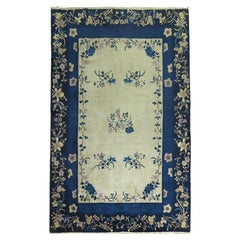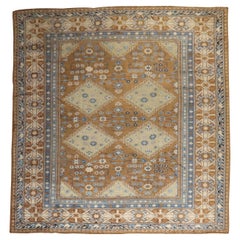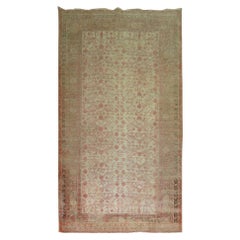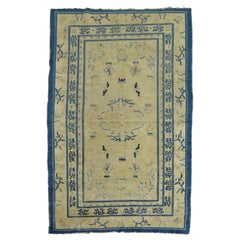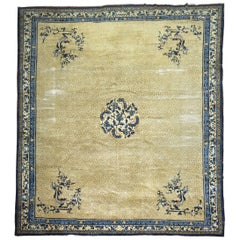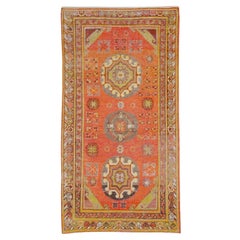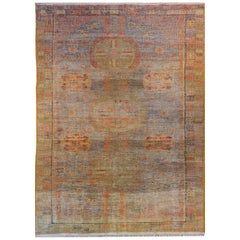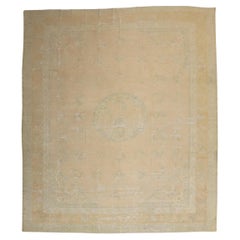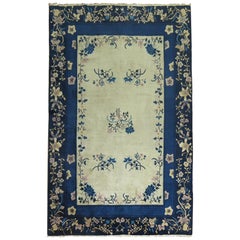Archaistic Chinese and East Asian Rugs
to
1
Width
to
Length
to
5
1,251
431
51
39
36
10
8
6
5
5
3
2
2
1
1
4
4
5
5
5
5
5
5
5
5
5
2
Style: Archaistic
Zabihi Collection Cream and Blue Chinese Rug
Located in New York, NY
An early 20th-century floral Chinese rug in beige and navy Blue
6'2'' x 9'
Peking rugs consist of designs that are simpler and asymmetrical, often tending toward modern western Art...
Category
Early 20th Century Chinese Archaistic Chinese and East Asian Rugs
Materials
Wool
Zabihi Collection Large Antique Khotan Rug
Located in New York, NY
Rare Room size Antique Khotan Rug from the 1st quarter of the 20th Century
Measures: 10'10" x 13'7"
Khotan rugs were produced in Eastern Turkestan. Khotan produced fine rugs in the...
Category
Early 20th Century East Turkestani Archaistic Chinese and East Asian Rugs
Materials
Wool
Pomegranate Khotan Shabby Chic Late 19th Century Large Gallery Size Rug
Located in New York, NY
Large antique shabby chic Khotan rug with an all-over Pomegranate Design with faded red and brown hues on a gray ground
Measures: 8'5" x 16'8"
Khotan rugs were produced in East...
Category
19th Century East Turkestani Antique Archaistic Chinese and East Asian Rugs
Materials
Wool
Zabihi CollectionTan Blue Color Early 20th Chinese Peking Oriental Antique Rug
Located in New York, NY
Rare size Chinese Peking rug in tan and blue,
circa 1910, measures: 4'11" x 7'6"
Peking rugs consist of designs that are simpler and asymmetrical, often tending toward modern western Art...
Category
Early 20th Century Chinese Archaistic Chinese and East Asian Rugs
Materials
Wool
$2,750 Sale Price
50% Off
Oversize Chinese Shabby Chic Peking Rug
Located in New York, NY
An oversize Chinese Peking rug in tans and blue.
Peking rugs consist of designs that are simpler and asymmetrical, often tending toward modern western art...
Category
Early 20th Century Chinese Archaistic Chinese and East Asian Rugs
Materials
Wool
Related Items
Early 20th Century Handmade East Turkestan Khotan Accent Rug
Located in New York, NY
An antique East Turkestan Khotan accent rug handmade during the early 20th century.
Measures: 4' 9" x 8' 11"
Category
Early 20th Century East Turkestani Archaistic Chinese and East Asian Rugs
Materials
Wool
Handsome Early 20th Century Khotan Rug
Located in Chicago, IL
A handsome early 20th century Central Asian Khotan rug with three circular medallions in the center amidst a field of stylized flowers and trees-of-life surrounded by a border contai...
Category
1930s Central Asian Vintage Archaistic Chinese and East Asian Rugs
Materials
Wool
Bobyrug’s Beautiful Vintage Pink Chinese Rug
Located in Saint Ouen, FR
Nice 20th century Chinese rug with Chinese design and beautiful colors with pink, blue, yellow and green, entirely hand knotted with wool velvet on cotton foundations.
✨✨✨
"Experien...
Category
Late 20th Century Chinese Archaistic Chinese and East Asian Rugs
Materials
Wool, Cotton
Antique Chinese Pictorial Rug with Deer and Crane Figures
Located in Atlanta, GA
Measures: 5' x 7'7.
This enchanting east Chinese rug incorporates five symbols of longevity: the deer, the crane, a tree, rocks and water. Originally of Chinese origin, the symbols took on a secular presence within Tibetan art. The four corners contain objects that are artistic and scholarly in nature. The rug was probably intended to bring the owner the good fortune of a long life matched with great intelligence and artistic ability.
Antique Chinese pictorial rug with deer...
Category
Early 20th Century Nepalese Archaistic Chinese and East Asian Rugs
Materials
Wool
Tibetan China Rug Pure Wool Hand Knotted by Djoharian Collection Antique Design
Located in Lohr, Bavaria, DE
A Tibetan rug with antique Chinese design, hand knotted in Nepal.
This traditional rug design is typically found on antique rugs from China. The blue ground is often found in Peki...
Category
2010s Nepalese Archaistic Chinese and East Asian Rugs
Materials
Wool
$2,502 Sale Price
30% Off
W 78.75 in L 96.46 in
Djoharian Collection Tiger Rug Hand Knotted Antique Tibetan Design
Located in Lohr, Bavaria, DE
A Djoharian Collection Tiger rug, hand knotted in Nepal - 6.0 x 3.0 ft
Origin: Nepal
Pile material: 100% Wool
Colors: Lilac, Orange, Pink
Warp and weft: Cotton
Design: Tiger Rug
Len...
Category
2010s Nepalese Archaistic Chinese and East Asian Rugs
Materials
Wool
$1,396 Sale Price
20% Off
W 36.23 in L 70.87 in
Tibetan Tiger Rug Hand Knotted Wool and Silk Gold Blue by Djoharian Collection
Located in Lohr, Bavaria, DE
A Tibetan Tiger rug, hand knotted in Nepal, silk and wool pile.
This traditional Tiger rug design is typically found on antique rugs called Khaden. It describes a small sized rug of...
Category
2010s Nepalese Archaistic Chinese and East Asian Rugs
Materials
Wool, Silk
$7,833 Sale Price
20% Off
W 78.75 in L 118.12 in
Antique Chinese Peking Rug with Romantic Chinoiserie Style
Located in Dallas, TX
77446 Antique Chinese Peking Rug with Romantic Chinoiserie Style 06'02 x 08'08. This hand knotted wool antique Chinese Peking rug is a rare and distinguished treasure, woven with the...
Category
Early 20th Century Chinese Archaistic Chinese and East Asian Rugs
Materials
Wool
Antique Blue Chinese Peking Rug, Chinoiserie Chic Meets Regal Decadence
Located in Dallas, TX
78762 Antique Blue Chinese Peking Rug, 04'00 x 05'09. Chinese Peking rugs, originating from Beijing (formerly known as Peking), China, are renowned for their intricate designs, vibra...
Category
Early 20th Century Chinese Archaistic Chinese and East Asian Rugs
Materials
Wool
Dragon Rug Pillar Column Rug Chinese Dragon Hallway Stairway Runner
Located in Lohr, Bavaria, DE
Dragon Rug Pillar Column Rug Chinese Dragon Hallway Stairway Runner
Dragon Rug - they were used as pillar column rugs. Chinese temple design for hall...
Category
2010s Nepalese Archaistic Chinese and East Asian Rugs
Materials
Wool
Antique Chinese Peking Accent Rug with Chinese Art Deco Style
Located in Dallas, TX
74478, antique Chinese Peking Accent rug with Chinese Art Deco style. This antique Peking rug showcases a beautiful Chinese Art Deco style. It has a circular shaped central medallion...
Category
Early 20th Century Chinese Archaistic Chinese and East Asian Rugs
Materials
Wool
Early 20th Century Designed Antique Peking Chinese Wool Rug In Navy Blue
Located in Norwalk, CT
Beautiful antique Chinese Art Deco rug, hand-knotted wool with a navy blue field and light brown frame featuring a subtle classic Chinese floral design.
This rug measures: 3'11" x 6...
Category
Early 20th Century Chinese Archaistic Chinese and East Asian Rugs
Materials
Wool
Previously Available Items
Zabihi Collection 19th Century Neutral Chinese Antique Square Rug
Located in New York, NY
3rd quarter of the 19th century Century Worn/Distressed Chinese Large square rug in neutral colors
Measures: 10'10'' x 12'11''
Category
Late 19th Century Antique Archaistic Chinese and East Asian Rugs
Materials
Wool
Cream and Blue Chinese Rug
Located in New York, NY
An early 20th century floral Chinese rug in beige and navy Blue
6'2'' x 9'
Peking rugs consist of designs that are simpler and asymmetrical, often tending toward modern western Art...
Category
Early 20th Century Chinese Archaistic Chinese and East Asian Rugs
Materials
Wool
Archaistic chinese and east asian rugs for sale on 1stDibs.
Find a broad range of unique Archaistic chinese and east asian rugs for sale on 1stDibs. Many of these items were first offered in the Early 20th Century, but contemporary artisans have continued to produce works inspired by this style. If you’re looking to add vintage chinese and east asian rugs created in this style to your space, the works available on 1stDibs include rugs and carpets and other home furnishings, frequently crafted with fabric, wool and other materials. If you’re shopping for used Archaistic chinese and east asian rugs made in a specific country, there are Asia, China, and East Asia pieces for sale on 1stDibs. It’s true that these talented designers have at times inspired knockoffs, but our experienced specialists have partnered with only top vetted sellers to offer authentic pieces that come with a buyer protection guarantee. Prices for chinese and east asian rugs differ depending upon multiple factors, including designer, materials, construction methods, condition and provenance. On 1stDibs, the price for these items starts at $5,500 and tops out at $27,500 while the average work can sell for $14,250.
Recently Viewed
View AllMore Ways To Browse
Vintage Storage Box With Lid
Vintage Storage Boxes With Lids
Vintage Towel Cabinet
Vintage Wood Record Cabinet
Vintage Wood Stereo Cabinet
Virginia Mahogany
Wallace Aegean Weave
Wallace Sterling Waltz Of Spring
Wallace Violet Sterling Silver Flatware
Wallace Violet Sterling
Walnut Dresser And Nightstands
Wardrobe Arch
Washstand Commode
Waterford Crystal Wine Glasses
Wave Drawers
Wedgwood Fish
White Ceramic Swan
White Swan Planter
